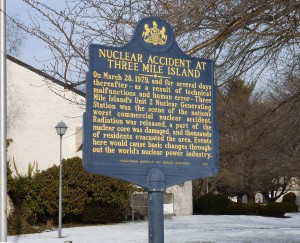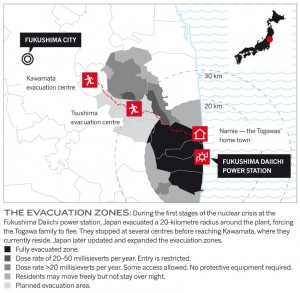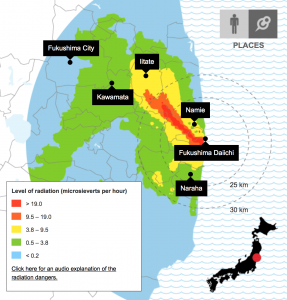Introduction
Generating electricity from nuclear power requires nuclear power plants. While these can be helpful and efficient ways to generate electricity, there are also downfalls. One of the main downfalls is that if there is a problem with the nuclear reactor, there can be health effects. The worst case scenario is a nuclear disaster, where radioactive gasses are released and living things in the area (including plants, animals, and people) become ill and even die.
In this blog post, I will talk about two nuclear disasters: Three Mile Island, which took place in the United States, and Fukushima, which took place in Japan. I will explain what happened in these disasters, why the disaster occurred, and will finish the post by saying what can be done to make nuclear energy safer.
Three Mile Island

Three Mile Island is a nuclear energy generating station in Pennsylvania. The above picture commemorates the nuclear disaster that took place at the station in 1979.
What Happened
The Three Mile Island nuclear accident did not result in negative health effects of plant workers or residents, according to the government, but was the most serious commercial nuclear disaster in the US and it brought about changes and reform.
What ultimately happened was that a cooling system for the reactor broke down because a valve was stuck open and coolant was pouring out, but the employees did not know this. Therefore, the coolant leaked out and caused the reactor to overheat and melt down. This is similar to if a radiator in a car runs out of coolant and the engine overheats and breaks.
Why it Happened
The story of why it happened has several steps. First, the problem only happened in one of two reactors. In that reactor, the problem started in a non-nuclear part. A cooling system stopped working right, and this caused a buildup of pressure in the nuclear part. That was okay, because then a valve opened to allow the pressure to escape.
Where the problem came was that the employees thought the valve had closed, but it hadn’t. Coolant started pouring out the valve, so it was not cooling the reactor. The reactor started to overheat, and alarms went off, but the employees had no idea what was going on. They actually took actions that made the situation worse without realizing it. Finally, the core started to melt, and this was when the actual problem was discovered and addressed.
The plant workers did not actually get complete control of the plant back until Day 10 of the disaster. The community around the plant had to be evacuated until this time.
Fukushima

On March 11, 2011, a large earthquake and tsunami hit Japan and did considerable damage. It hit the Fukushima power station, which has 11 nuclear reactors. Luckily, the reactors survived the earthquake, but the tsunami caused damage that led to the Fukushima nuclear disaster.
What Happened
In March of 2011, an earthquake occurred followed by a tsunami, and interestingly, the 11 reactors of the Fukushima plant all survived the earthquake. Seismically, the reactors proved resistant to damage, but their operations were vulnerable to the tsunami.
All 11 reactors shut down as planned when the earthquake hit. Also, the power plant lost electrical power, and this caused them to revert to using back-up generators. However, there were not enough back-up generators to handle all the power needs since this was such a large power failure.
Why it Happened
The tsunami disabled 12 of the 13 backup generators. This caused the cooling system to be inadequate for 3 of the 11 reactors. The three units could not maintain proper reactor cooling and water circulation functions, and electrical switches were disabled. It took many weeks of dedicated work by employees to get the cooling system to begin functioning again and to get the reactors back online.
Below shows a map of the exposure from the disaster.

Making Nuclear Power Safer
In terms of Three Mile Island, the result of the disaster was reform. Public health investigations as well as lawsuits took place, and there were a lot of lessons learned about how to improve protocols at nuclear plants to make them safer.
However, the example at Fukushima shows that even the best plans cannot account for every situation. The fact is that nuclear energy involves dangerous mechanisms over which humans can lose control. The result can potentially be a huge loss of human life. Whenever a nuclear plant is built, the human race is placing a bet. Therefore, probably the safest approach to nuclear energy would be limiting it and finding less dangerous and more sustainable approaches to generating energy.
Conclusion
Three Mile Island, which took place in the US, and Fukushima, which took place in Japan, represent two modern nuclear disasters. Even though the result was not widespread death and injury, the events were enough to strike fear into the local populations. The result of the Three Mile Island incident was reform, but ultimately, the safest approach with nuclear energy would be to limit the number of reactors in the world so as to limit the risk of a nuclear disaster.